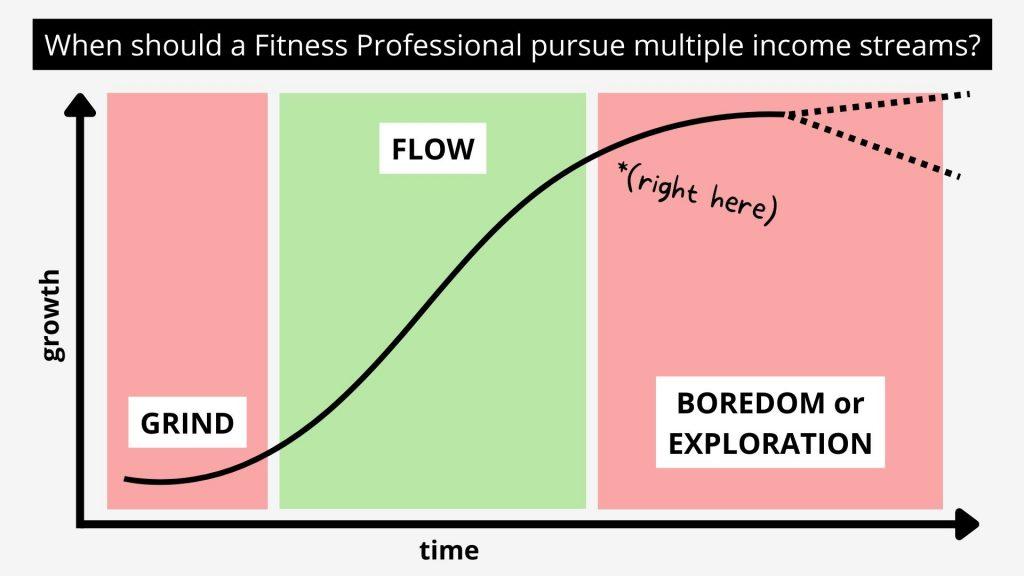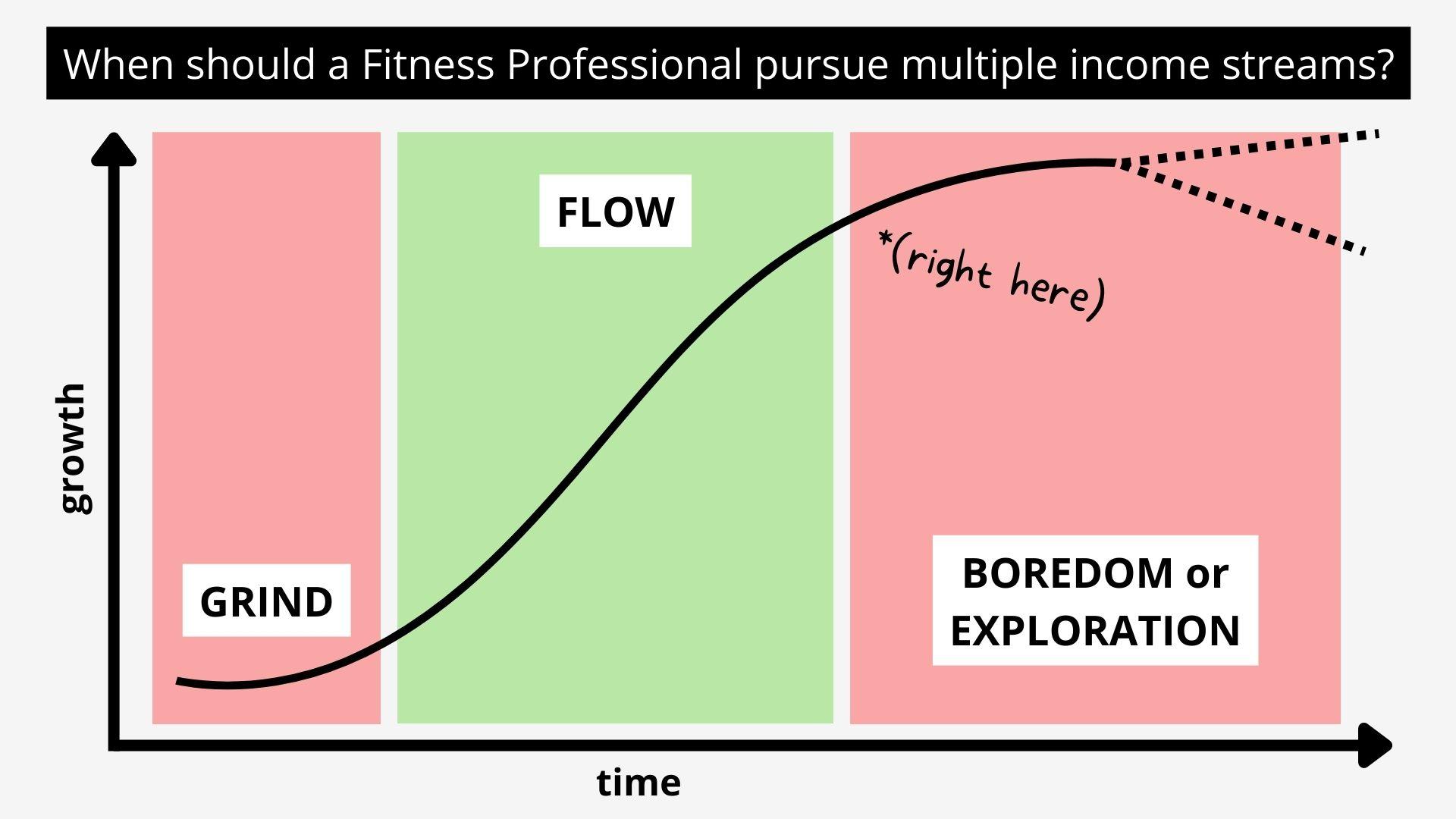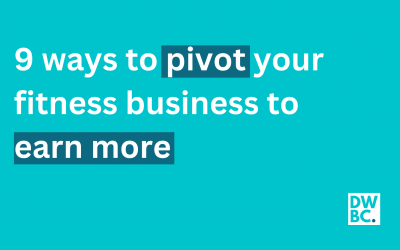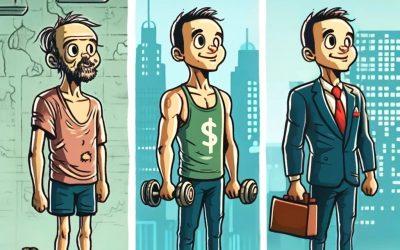Are you a Fitness Professional who wants to develop multiple income streams? A ‘fitness-preneur’?
You’re not alone. The entrepreneurial spark is well-and-truly alive in Fit Pros.
But when is the best time to branch out? When should you look for income stream number two (or three or four or five)?
Start a new venture too early, and you’re likely to compromise your primary source of income. Wait too long, and you’re likely to join the huge number of Fitness Professionals who burn out (learn about why Fitness Professionals have such short careers).
There’s one simple chart that can help us pin-point the moment to diversify – and it’s an s-shaped curve.

Zone one is ‘GRIND’ hard, hustling work. This is where the phrase ‘a rocket uses 80% of its fuel getting off the ground’ applies. In this stage, you do a lot of work and seem to get no return. The return on investment is low. As a result, this is where many Fitness Professionals get disenchanted and, ultimately, drop out of the industry. Early mornings, late nights. Hard work, with little to show for it. Working for every dollar, and working ‘in’ the business, not ‘on the business’.
A lot of people work their entire careers (short though they may be) in this first phase.
They get disenchanted and look for an easier path. That ‘easier path’ is often a misguided attempt to find multiple income streams (online programming, nutrition coaching, selling supplements etc).
They end up in a ’tug-of-war’ between different pursuits, with each cannibalising the success of the others. Their lack of time becomes an even bigger problem and their (multiple) businesses start to fail.
The majority of Fitness Professionals never leave the ‘grind’ stage. They work forever on exchanging their time for money.
For a select few, however, instead of chasing multiple income streams and new ideas, they spend the majority of their time getting better at their craft (‘be so good they can’t ignore you’) and manage to spend the small amount of the free time they do have working ‘on’ the business (learn more about finding long-term clients early in your career). They build the expertise and the systems that will allow them to graduate to the second stage – flow. And in some cases, it can take years to get to this stage.
In the flow stage, they finally start to get a return on the hard work they put in. In ‘flow’, Fitness Professionals are able to exchange their money for time, leveraging the systems they’ve built to generate more income. Importantly though, they’re still focussed on the primary elements of their business that have the greatest guaranteed return. They resist the urge to chase ‘shiny objects’ and the next big idea.
In the grind stage, you got a small return from a huge amount of work. In the flow stage however, you get a much larger return from that work. Don’t get me wrong, you’re still working very hard, but the hard work now seems easier because you’re seeing a return on the investment.
The ‘flow’ stage is the dream. You love what you’re doing, and you’re rewarded financially for it. You have purpose.
But after a while, you stumble upon the ‘self actualisation’ of running a business. You’ve spent your whole career thinking that life would be great if you could generate a passive income, but then once you have that, you question what you should actually do with your rapidly expanding free time. And you come to realise that you miss the grind, you miss the struggle.
You start to understand what Victor Frankl meant by “What man actually needs is not a tensionless state, but rather, the striving and struggle for some goal worthy of him”, and “Meaning is a feeling and is created by three things, you have a project you’re working on, you have an optimistic perspective on your suffering, you have a community to share you experiences with.”
It’s the suffering (with an optimistic perspective) that you’re missing.
Welcome to the ‘boredom or exploration’ phase. And you get to choose which one it will be for you.
Either you keep doing what you’re doing, with a great return on your work, but a lack of challenge, or, you start a new s-curve, building it on top of the curve you’ve already developed.
By this stage, your business is well systemised and well automated. You’ve delegated the day-to-day operations of your business and (for you at least) a lot of your business is on autopilot.
It’s time to explore.
Time to find a new challenge and, as Frankl would put it, a new form of suffering to be optimistic about.
Now is the time to be the ‘fitness-preneur’ and to chase the shiny ideas you’ve got.
Every now and then you’ll get pulled back to your primary business, and that’s fine, it comes with the territory.
Of course, for a lot of people, it’s impossible to completely turn off their ‘entrepreneurial spirit’ during the struggle phase of building their business. If that’s you, you’ll need to ‘segregate’ or ‘compartmentalise’ your ‘new ventures’ to ensure they don’t bleed into your primary business. Maybe allow yourself a maximum of two hours a week to work on these ‘experimental projects’. We dive deep into how this strategy can work for you here.
For most people though, ‘chasing the latest idea’ happens too early. People become ‘overstarters’. Seth Godin describes an overstarter as “…someone who takes on new projects before the current projects are finished. While it’s great to have an endless supply of new ideas, overstarting can also be a form of self sabotage. When you’re initiating something, you need to commit to devoting the time and effort required to see it through to the end.”
Where are you on the curve? Are you focussing on the right things in your business? Are you self sabotaging future success in the pursuit of (unlikely) extra success today?





